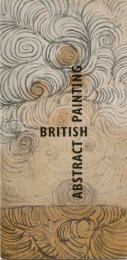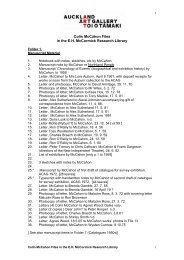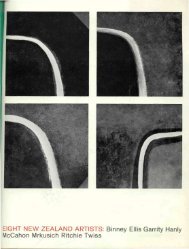You also want an ePaper? Increase the reach of your titles
YUMPU automatically turns print PDFs into web optimized ePapers that Google loves.
Paintingsresidues from smoke and aerosols can cause a great dealof damage. Dust can become ingrained in the paint layeror attract water to the surface, encouraging mouldgrowth.HandlingBefore moving an object, painting, or frame, examine itfor damage. If damage exists, carefully collect and saveany pieces, no matter how small. This practice willgreatly assist the conservator.If loose paint is present on a painting or polychromestatue, make no attempt to move or handle the piece.Instead, contact a conservator for advice and assessmentof the damage. Paintings with lifting or flaking paintshould be kept flat, paint surface up.Paintings must be secure in their frames. If they areloose, do not move or handle them until they are safelyfixed. Before hanging a painting, be sure its hangingdevices are firm.Do not handle, move, or carry more than one paintingat a time. Large paintings should be moved by atleast two people, regardless of the weight involved.Never carry a painting by the top of its frame orstretcher. Carry with one hand on each side. Never putyour hands between the stretcher bar and canvas as thiscan cause serious damage to the paint layer.Do not touch the surface of a painting with hands orcloth. Avoid direct contact with painted surfaces at alltimes. Wearing white cotton gloves while handling paintingsis always advisable; clean hands are not enough.Perspiration will damage both paintings and frames aswell as fabric mats and liners.Never apply tape or adhesive either to the front orback of a painting or to the visible parts of the frame.Do not attach labels or write on the back of a canvaspainting.Handle works of art as little and as infrequently aspossible. Avoid home-restoration attempts, as you arevery likely to cause irreversible damage. Leave conservationto the experts.Remember that damage caused by careless handlingfrequently does not become visible for a considerabletime. If the surface of a painting is bumped, it may bemonths or years before cracking and lifting of the paintsurface appears.DisplayPaintings are traditionally framed for display purposesas this provides protection as well as enhancing theimage. However the protective function must take priorityover the decorative, or the frame itself can causedamage.If the artist did not want the picture framed, then itwill have to be hung from its support. Additional protectioncan be provided to unframed paintings on solid supportsor solid auxiliary supports during transportationand storage by the use of travelling frames. These areattached to the back and have the same disadvantages asshadow frames (see also page 36). They provide protectionaround the edges and front surface by projectingout past the picture plane. Travelling frames can also beused to protect large ornate and delicate frames duringtransportation and when in storage.Unstretched paintings on canvas are not normallyframed and are intended to hang directly from the wall.Those with metal eyelets along the top edge can be hungfrom nails in the wall, but pinning or nailing directlythrough the canvas is not recommended as it can causedistortions and tearing. Velcro can be used to hangunstretched paintings, in a method similar to thatdescribed for textiles (see also page 43). A strip of Velcrois invisibly sewn or adhered to the top reverse of thepainting, and the matching Velcro attached to a strip ofwood or plywood that can be hung on the wall. A conservatorcan give advice as to the most suitable hangingmethod.FramingGeneral Points to Remember—the frame must besubstantial enough to hold the picture, and not so weak33
















